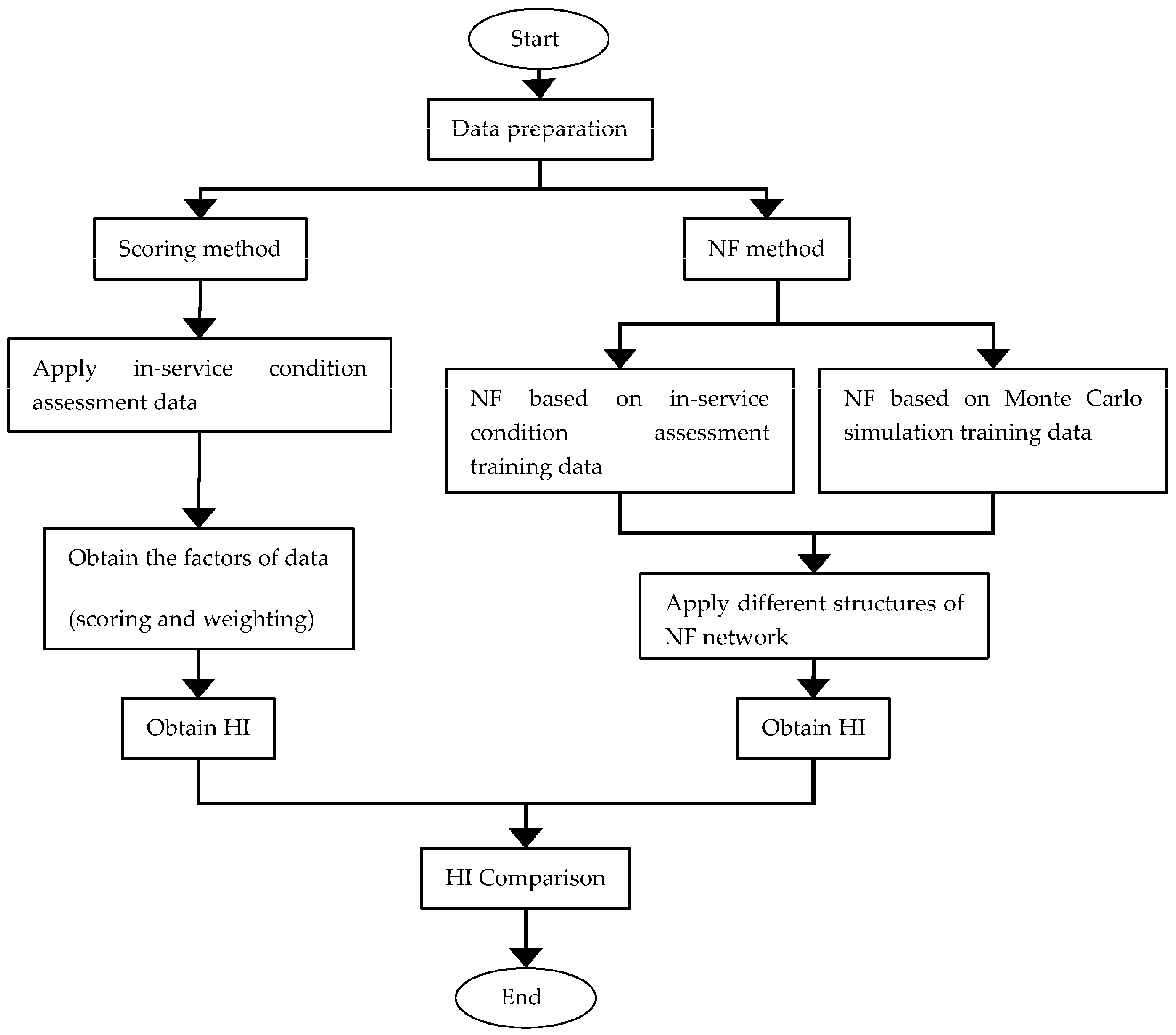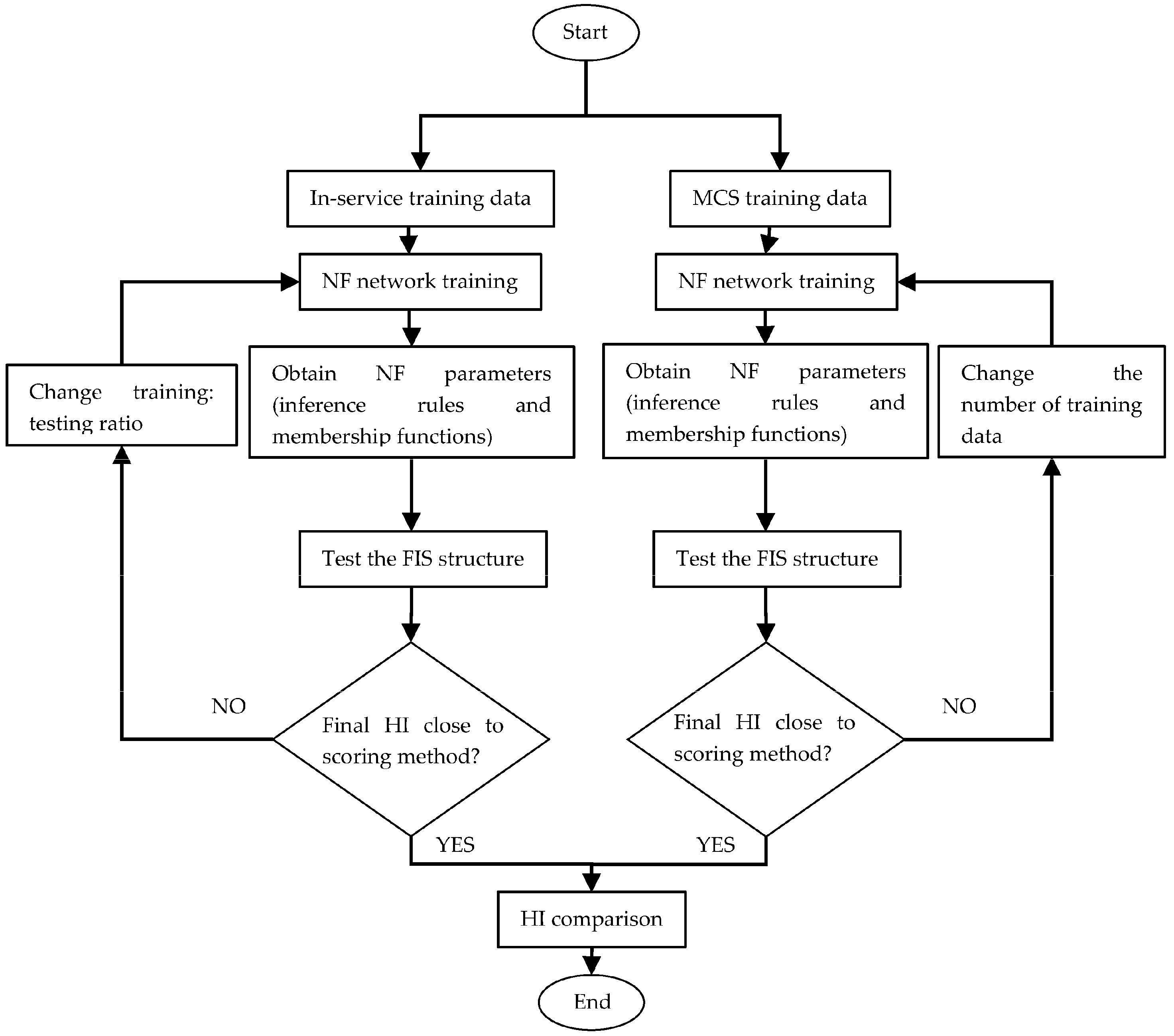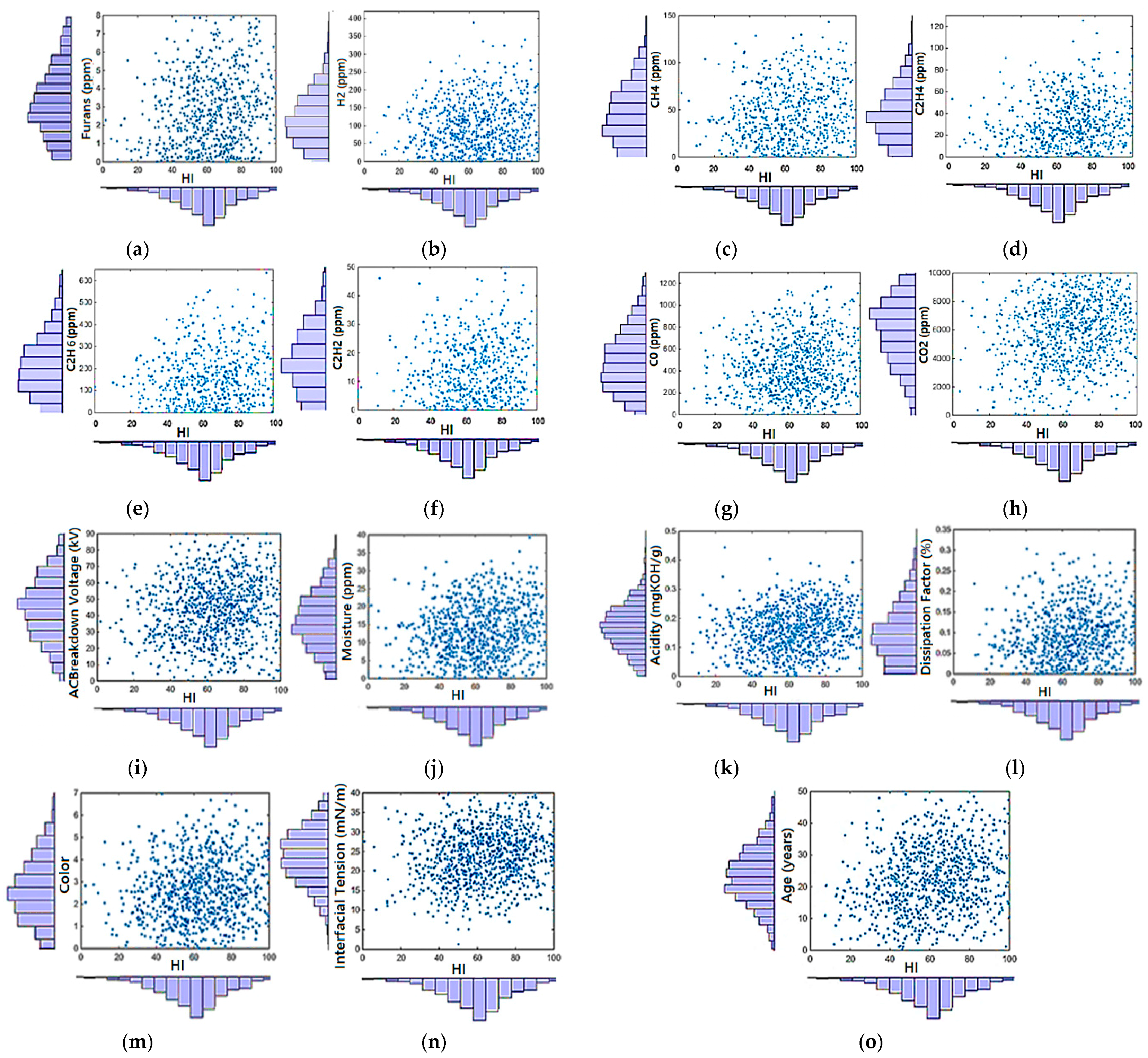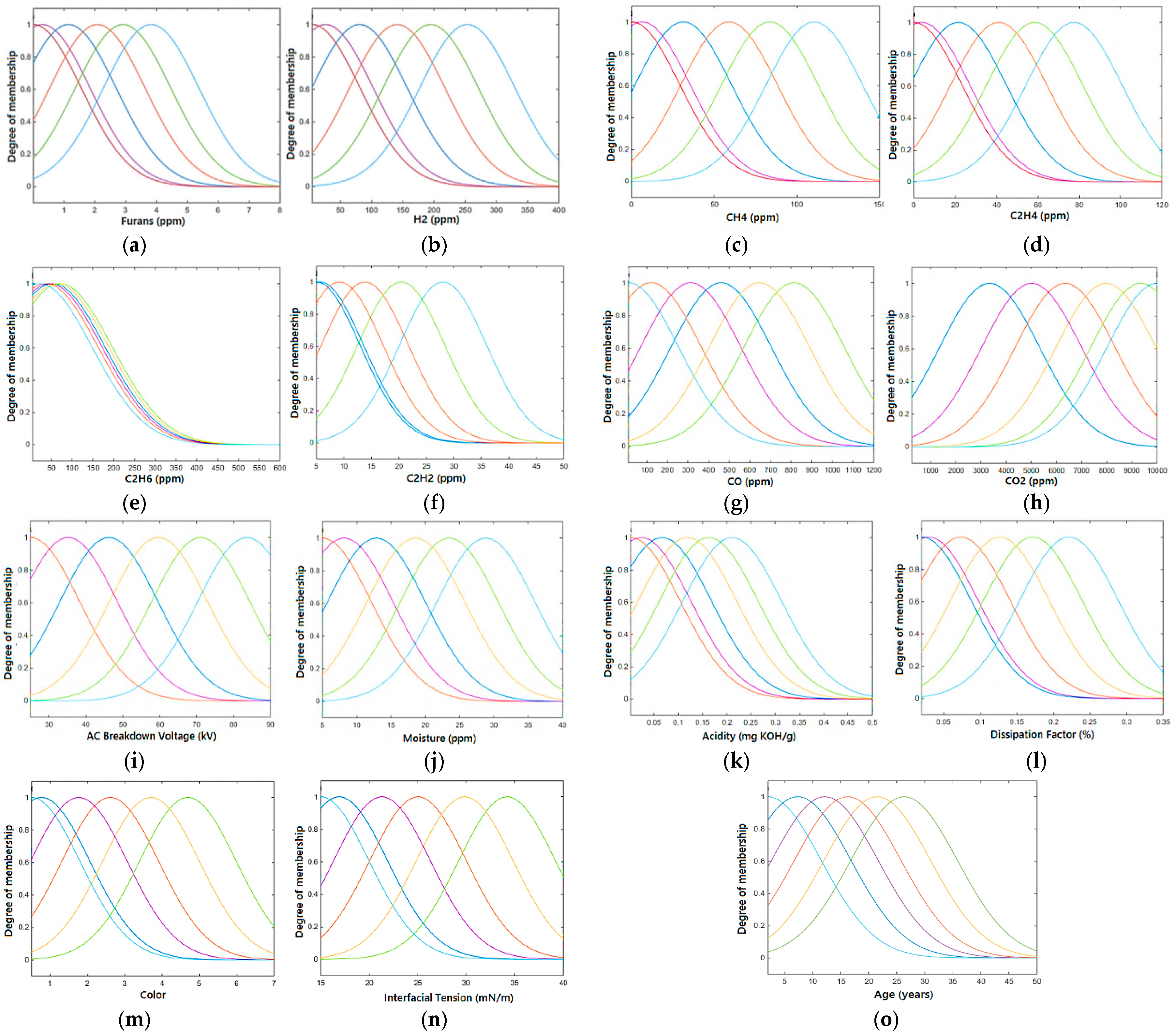Transformers Health Index Assessment Based on Neural-Fuzzy Network
Abstract
:1. Introduction
2. Research Work Flow
3. Health Index Assessment Based on Scoring Method
4. Health Index Assessment Based on Neural Fuzzy Method
4.1. Architecture of the Neural Fuzzy Network
4.2. Data Training
4.2.1. Training Based on In-Service Condition Assessment Data
4.2.2. Training Based on Monte Carlo Simulation
4.3. Membership Function
5. Result and Discussion
6. Conclusions
Acknowledgments
Author Contributions
Conflicts of Interest
Nomenclature
| Score for each parameter. | |
| Weighting factor for individual condition parameter. | |
| Number of parameter in each factor. | |
| Weighting factor for transformers condition parameter. | |
| Rating code for each parameter. | |
| Output layer. | |
| Linguistic label. | |
| Centre of the Gaussian function. | |
| Parameter set in the consequent. | |
| Spread of the membership function. | |
| Type of membership function. | |
| The crisp inputs to node. | |
| Normalized degrees of activation (firing strength) | |
| Degrees of activation (firing strength) of ith rules | |
| ith nodes output from the previous layer | |
| The node function. | |
| Data | |
| Mean | |
| Standard deviation |
References
- Wu, Q.H.; Tang, W.H. Condition Monitoring and Assessment of Power Transformers Using Computational Intelligence; Springer: London, UK, 2011. [Google Scholar]
- CIGRE Working Group A2.18. Guide for Life Management Techniques for Power Transformer; International Council on Large Electric Systems: Paris, France, 2003; Volume 227. [Google Scholar]
- Chakravorti, S.; Dey, D.; Chatterjee, B. Recent Trends in the Condition Monitoring of Transformers: Theory, Implementation and Analysis; Power Systems; Springer: London, UK, 2013; Volume 67. [Google Scholar]
- Jahromi, A.; Piercy, R.; Cress, S.; Service, J.; Fan, W. An approach to power transformer asset management using health index. IEEE Electr. Insul. Mag. 2009, 25, 20–34. [Google Scholar] [CrossRef]
- Waugh, N.T.; Muir, D.D. Improving the life cycle management of power transformers transforming data to life. In Proceedings of the SoutheastCon, Fort Lauderdale, FL, USA, 9–12 April 2015; pp. 1–7. [Google Scholar]
- Taengko, K.; Damrongkulkamjorn, P. Risk assessment for power transformers in PEA substations using health index. In Proceedings of the 10th International Conference on Electrical Engineering/Electronics, Computer, Telecommunications and Information Technology (ECTI-CON), Krabi, Thailand, 15–17 May 2013; pp. 1–6. [Google Scholar]
- Zhang, X.; Gockenbach, E. Asset-Management of Transformers Based on Condition Monitoring and Standard Diagnosis [Feature Article]. IEEE Electr. Insul. Mag. 2008, 24, 26–40. [Google Scholar] [CrossRef]
- Wang, M.; Vandermaar, A.J.; Srivastava, K.D. Review of condition assessment of power transformers in service. IEEE Electr. Insul. Mag. 2002, 18, 12–25. [Google Scholar] [CrossRef]
- De Pablo, A. Furfural and ageing: How are they related. In Proceedings of the IEEE Colloquium on Insulating Liquids (Ref. No. 1999/119), Leatherhead, UK, 27–27 May 1999. [Google Scholar]
- Schaut, A.; Autru, S.; Eeckhoudt, S. Applicability of methanol as new marker for paper degradation in power transformers. IEEE Trans. Dielectr. Electr. Insul. 2011, 18, 533–540. [Google Scholar] [CrossRef]
- Matharage, S.Y.; Liu, Q.; Wang, Z.D.; Mavrommatis, P.; Wilson, G.; Jarman, P. Ageing assessment of transformer paper insulation through detection of methanol in oil. In Proceedings of the IEEE 11th International Conference on the Properties and Applications of Dielectric Materials (ICPADM), Sydney, Australia, 19–22 July 2015; pp. 392–395. [Google Scholar]
- Bakar, N.A.; Abu-Siada, A.; Islam, S. A review of dissolved gas analysis measurement and interpretation techniques. IEEE Electr. Insul. Mag. 2014, 30, 39–49. [Google Scholar] [CrossRef]
- Abu-Siada, A.; Islam, S. A new approach to identify power transformer criticality and asset management decision based on dissolved gas-in-oil analysis. IEEE Trans. Dielectr. Electr. Insul. 2012, 19, 1007–1012. [Google Scholar] [CrossRef]
- Nemeth, B.; Laboncz, S.; Kiss, I. Condition monitoring of power transformers using DGA and Fuzzy logic. In Proceedings of the IEEE Electrical Insulation Conference (EIC), Montreal, QC, Canada, 31 May–3 June 2009; pp. 373–376. [Google Scholar]
- Montanari, G.C.; Morshuis, P.; Cervi, A. Monitoring HV transformer conditions: The strength of combining various diagnostic property observations. In Proceedings of the IEEE Electrical Insulation Conference (EIC), Seattle, WA, USA, 7–10 June 2015; pp. 141–144. [Google Scholar]
- Naderian, A.; Cress, S.; Piercy, R.; Wang, F.; Service, J. An Approach to Determine the Health Index of Power Transformers. In Proceedings of the IEEE International Symposium on Electrical Insulation (ISEI), Vancouver, BC, Canada, 9–12 June 2008; pp. 192–196. [Google Scholar]
- Phadungthin, R.; Haema, J. Risk optimization of power transformer tank and accessories: Practical experiences in Thailand. In Proceedings of the 2015 50th International Universities Power Engineering Conference (UPEC), Stoke on Trent, UK, 1–4 September 2015; pp. 1–6. [Google Scholar]
- Singh, J.; Sood, Y.R.; Jarial, R.K. Condition Monitoring of Power Transformers—Bibliography Survey. IEEE Electr. Insul. Mag. 2008, 24, 11–25. [Google Scholar] [CrossRef]
- Ashkezari, A.D.; Hui, M.; Saha, T.K.; Ekanayake, C. Application of fuzzy support vector machine for determining the health index of the insulation system of in-service power transformers. IEEE Trans. Dielectr. Electr. Insul. 2013, 20, 965–973. [Google Scholar] [CrossRef]
- Abu-Elanien, A.E.B.; Salama, M.M.A.; Ibrahim, M. Calculation of a Health Index for Oil-Immersed Transformers Rated Under 69 kV Using Fuzzy Logic. IEEE Trans. Power Deliv. 2012, 27, 2029–2036. [Google Scholar] [CrossRef]
- Abu-Elanien, A.E.B.; Salama, M.M.A.; Ibrahim, M. Determination of transformer health condition using artificial neural networks. In Proceedings of the International Symposium on Innovations in Intelligent Systems and Applications (INISTA), Istanbul, Turkey, 15–18 June 2011; pp. 1–5. [Google Scholar]
- Ahmed, M.; Elkhatib, M.; Salama, M.; Shaban, K.B. Transformer Health Index estimation using Orthogonal Wavelet Network. In Proceedings of the IEEE Electrical Power and Energy Conference (EPEC), London, ON, Canada, 26–28 October 2015; pp. 120–124. [Google Scholar]
- Haema, J.; Phadungthin, R. Condition assessment of the health index for power transformer. In Proceedings of the IEEE Power Engineering and Automation Conference (PEAM), Wuhan, China, 18–20 September 2012; pp. 1–4. [Google Scholar]
- Jang, J.S.R. ANFIS: Adaptive-network-based fuzzy inference system. IEEE Trans. Syst. Man Cybern. 1993, 23, 665–685. [Google Scholar] [CrossRef]
- Sediva, S.; Uher, M.; Havlikova, M. Application of the Monte Carlo method to estimate the uncertainty of air flow measurement. In Proceedings of the 16th International Carpathian Control Conference (ICCC), Szilvasvarad, Hungary, 27–30 May 2015; pp. 465–469. [Google Scholar]
- IEEE Guide for the Interpretation of Gases Generated in Oil-Immersed Transformers; IEEE Std C57.104-2008 (Revision of IEEE Std C57.104-1991); IEEE: New York, NY, USA, 2009; pp. 1–36.





| Transformer | T1 | T2 | T3 | T4 | T5 | T6 | T7 | T8 | T9 | T10 | T11 | T12 | T13 | T14 | T15 |
|---|---|---|---|---|---|---|---|---|---|---|---|---|---|---|---|
| Furans (ppm) | 3.34 | 1.68 | 1.43 | 1.4 | 0.6 | 0.1 | 0.1 | 0.13 | 0.32 | 0.401 | 0 | 0.12 | 0.08 | 0.08 | 0.05 |
| H2 (ppm) | 22 | 98 | 70 | 8 | 12 | 8 | 88 | 180 | 503 | 277 | 11 | 13 | 12 | 14 | 134 |
| CH4 (ppm) | 103 | 122 | 6 | 4 | 1 | 2 | 168 | 126 | 7 | 20 | 4 | 2 | 2 | 2 | 32 |
| CO (ppm) | 783 | 781 | 578 | 631 | 17 | 172 | 356 | 473 | 305 | 335 | 395 | 206 | 146 | 127 | 245 |
| CO2 (ppm) | 3501 | 4784 | 8551 | 6535 | 286 | 3382 | 6080 | 7821 | 6561 | 2416 | 2700 | 2764 | 2123 | 1766 | 3086 |
| C2H4 (ppm) | 18 | 46 | 2 | 116 | 0 | 15 | 24 | 16 | 2 | 1 | 4 | 14 | 6 | 4 | 3 |
| C2H6 (ppm) | 93 | 105 | 3 | 1 | 0 | 0 | 615 | 373 | 15 | 35 | 1 | 0 | 0 | 0 | 44 |
| C2H2 (ppm) | 0 | 5 | 0 | 0 | 2 | 0 | 0 | 0 | 0 | 0 | 0 | 0 | 0 | 0 | 0 |
| Moisture (ppm) | 35 | 23 | 9 | 10 | 12 | 12 | 4 | 4 | 7 | 7 | 3 | 11 | 10 | 8 | 3 |
| BDV (kV) | 27 | 25 | 57 | 48 | 48 | 26 | 49 | 49 | 55 | 69 | 97 | 57 | 27 | 31 | 94 |
| DF (%) | 0.26 | 0.034 | 0.008 | 0.12 | 0.03 | 0.004 | 0.03 | 0.03 | 0.02 | 0.033 | 0.002 | 0.008 | 0.003 | 0.003 | 0.003 |
| Acidity (mg KOH/g) | 0.43 | 0.23 | 0.15 | 0.085 | 0.086 | 0.03 | 0.02 | 0.01 | 0.03 | 0.045 | 0.02 | 0.031 | 0.017 | 0.015 | 0.014 |
| IFT (mN/m) | 16 | 15 | 17 | 22 | 18 | 32 | 25 | 25 | 24 | 23 | 30 | 30 | 32 | 35 | 30 |
| Color | 7 | 4 | 3 | 5 | 3 | 2 | 1.5 | 1.5 | 1 | 2 | 1 | 2 | 1.5 | 1 | 0.5 |
| Age (years) | 23 | 21 | 11 | 29 | 18 | 16 | 7 | 7 | 4 | 8 | 14 | 16 | 16 | 16 | 4 |
| Scoring method HI | VB | B | M | B | G | G | M | M | G | G | VG | VG | VG | VG | VG |
| 28 | 34.6 | 55 | 41.6 | 76.6 | 70 | 66.6 | 61.6 | 73 | 80 | 100 | 88.3 | 86.6 | 93.3 | 91.6 | |
| NF-IS HI | VB | VB | B | M | VG | G | G | G | G | G | G | VG | VG | VG | VG |
| 19.8 | 18 | 30 | 65 | 94 | 70 | 71 | 73 | 73 | 80 | 78 | 90 | 88 | 87 | 87 | |
| NF-MCS HI | VB | VB | B | B | M | G | G | G | G | G | VG | VG | VG | VG | VG |
| 20.4 | 22.6 | 35.5 | 45 | 57 | 80 | 78 | 81 | 71 | 73 | 88 | 85 | 85.6 | 91 | 86 |
| Transformer | T16 | T17 | T18 | T19 | T20 | T21 | T22 | T23 | T24 | T25 | T26 | T27 | T28 | T29 | T30 |
| Scoring method HI | M | B | G | G | G | G | VG | G | VG | G | B | VB | M | M | G |
| 54.8 | 45.2 | 71.2 | 71.2 | 80.8 | 80.8 | 85.6 | 84.6 | 85.6 | 70.2 | 44.2 | 29.8 | 60.6 | 66.3 | 79.8 | |
| NF-MCS HI | B | VB | VG | G | G | VG | VG | M | VG | VG | M | VB | M | VG | G |
| 36 | 29 | 85.2 | 74.1 | 83.1 | 85 | 89.4 | 59 | 100 | 87.8 | 62 | 19 | 51 | 86 | 83 | |
| Transformer | T31 | T32 | T33 | T34 | T35 | T36 | T37 | T38 | T39 | T40 | T41 | T42 | T43 | T44 | T45 |
| Scoring method HI | G | VG | VG | G | B | G | B | G | B | VG | VG | M | M | M | M |
| 84.6 | 85.6 | 85.6 | 80.8 | 49 | 71.2 | 39.4 | 71.2 | 45.2 | 100 | 94.2 | 59.6 | 53.8 | 66.3 | 56.7 | |
| NF-MCS HI | G | G | VG | G | B | G | B | VB | VG | VG | VG | M | M | M | M |
| 82 | 80 | 98 | 70 | 39.1 | 83.8 | 49.6 | 23 | 88.2 | 90 | 97.6 | 56.9 | 55.5 | 67.2 | 54.5 | |
| Transformer | T46 | T47 | T48 | T49 | T50 | T51 | T52 | T53 | T54 | T55 | T56 | T57 | T58 | T59 | T60 |
| Scoring method HI | B | M | M | M | G | G | VG | VG | VG | VG | B | B | G | G | VG |
| 44.2 | 59.6 | 64.4 | 64.4 | 74 | 74 | 100 | 88.5 | 100 | 100 | 38.5 | 44.2 | 76 | 79.8 | 95.2 | |
| NF-MCS HI | G | M | M | M | G | G | VG | VB | M | G | VB | M | G | VB | VG |
| 80.5 | 60.5 | 66 | 69 | 76 | 75.6 | 96 | 12.1 | 51 | 80.2 | 18.3 | 50 | 84.3 | 24.9 | 85.1 | |
| Transformer | T61 | T62 | T63 | T64 | T65 | T66 | T67 | T68 | T69 | T70 | T71 | T72 | T73 | ||
| Scoring method HI | VG | B | B | G | G | M | G | M | M | M | M | M | M | ||
| 85.6 | 34.6 | 44.2 | 83.7 | 83.7 | 61.5 | 71.2 | 66.3 | 61.5 | 54.8 | 59.6 | 59.6 | 50 | |||
| NF-MCS HI | M | B | VB | M | G | M | G | M | VG | M | M | M | VG | ||
| 58.5 | 31 | 22 | 60 | 78.8 | 50.3 | 70 | 62.8 | 96 | 50.6 | 55.7 | 55.8 | 95.5 |
© 2018 by the authors. Licensee MDPI, Basel, Switzerland. This article is an open access article distributed under the terms and conditions of the Creative Commons Attribution (CC BY) license (http://creativecommons.org/licenses/by/4.0/).
Share and Cite
Kadim, E.J.; Azis, N.; Jasni, J.; Ahmad, S.A.; Talib, M.A. Transformers Health Index Assessment Based on Neural-Fuzzy Network. Energies 2018, 11, 710. https://doi.org/10.3390/en11040710
Kadim EJ, Azis N, Jasni J, Ahmad SA, Talib MA. Transformers Health Index Assessment Based on Neural-Fuzzy Network. Energies. 2018; 11(4):710. https://doi.org/10.3390/en11040710
Chicago/Turabian StyleKadim, Emran Jawad, Norhafiz Azis, Jasronita Jasni, Siti Anom Ahmad, and Mohd Aizam Talib. 2018. "Transformers Health Index Assessment Based on Neural-Fuzzy Network" Energies 11, no. 4: 710. https://doi.org/10.3390/en11040710





